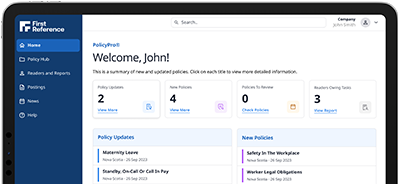
Canadian workplace training requirements: A guide to compliance in 2025
First Reference
Meeting Your Legal Training Obligations
Across Canada, employers face a complex web of legal obligations when it comes to training their workforce. As an employer in Canada, you’re likely focused on providing job-specific training to help your team succeed. However, beyond teaching employees how to perform their roles effectively, you have legal obligations to provide certain types of training—obligations that begin with your very first hire.
This guide examines the mandatory employee training requirements Canadian employers must fulfill in 2025, offering practical insights for HR professionals and business owners navigating this complex landscape.
Core Health & Safety Training Requirements
The foundation of mandatory workplace training in Canada rests firmly on health and safety legislation. Every province, territory, and the federal jurisdiction imposes certain baseline requirements.
Foundational Safety Instruction
All Canadian jurisdictions require employers to provide basic safety training. While specific requirements vary by province and territory, you’ll typically need to cover:
- Workplace hazard identification and mitigation strategies
- Proper use of safety equipment and protective gear
- Emergency response procedures and evacuation protocols
- Workers’ rights and responsibilities regarding workplace safety
- Reporting mechanisms for safety concerns and incidents
This training must be comprehensive enough to ensure workers can perform their duties without undue risk to themselves or others. Canadian workplace safety compliance begins with these foundational elements.
Anti-Harassment and Violence Prevention
In recent years, workplace harassment prevention training and violence prevention have become focal points of employment legislation across Canada. Your training program should educate workers on:
- Recognizing various forms of workplace harassment and violence
- Steps to take when experiencing or witnessing problematic behavior
- The organization’s policies regarding harassment and violence
- Available support resources and reporting procedures
- Bystander intervention techniques
For workers in higher-risk positions or those who frequently work alone, more extensive training may be required. Industries with increased public interaction, such as healthcare and retail, often face enhanced workplace violence prevention training requirements due to elevated risk factors.
Emergency Medical Response
Every workplace needs properly trained first aid providers. The specific first aid certification requirements for Canadian employers depend on:
- Your workplace’s proximity to emergency medical services
- The number of employees at your location
- The nature of workplace hazards and risk levels
Typically, you’ll need a certain number of employees trained in first aid techniques appropriate to your workplace’s risk profile. In remote locations or high-risk industries, more comprehensive training and additional first aid resources may be necessary.
Ergonomics and Injury Prevention
Many provinces have recognized the importance of preventing musculoskeletal injuries through proper ergonomic practices. If your workplace involves activities that could lead to such injuries, you likely need to provide ergonomic training compliance on:
- Proper lifting and carrying techniques
- Workstation setup and adjustment
- Early signs of repetitive strain injuries
- Available accommodations and assistive devices
- Rest and recovery best practices
This training is particularly important in manufacturing, warehousing, healthcare, and office environments where repetitive movements or heavy lifting occur regularly.
New Employee Onboarding
Special attention must be paid to new employees and young workers (typically defined as those under 25), who statistically face higher injury rates. Several provinces, including British Columbia, Manitoba, and New Brunswick, explicitly require specialized orientation for these workers.
These new employee safety orientation requirements should cover:
- Workplace-specific hazards and safety procedures
- The right to refuse unsafe work and how to exercise it
- Communication channels for safety concerns
- Supervised instruction for high-risk tasks
- Mentorship opportunities with experienced workers
Additional Required Training Programs
Supervisor Safety Responsibilities
Most jurisdictions recognize that supervisors play a crucial role in maintaining workplace safety. Consequently, employees with supervisory responsibilities typically require additional supervisor compliance training covering:
- Their legal obligations regarding worker safety
- Hazard assessment and control measures
- Incident investigation procedures
- Creating and maintaining safety documentation
- Effectively communicating safety information
This training helps ensure that those overseeing others understand their enhanced responsibilities for workplace safety.
Health & Safety Committee Members
Organizations required to maintain health and safety committees must provide specialized training to committee members. This joint health and safety committee certification typically covers:
- The committee’s legal duties and functions
- Effective meeting facilitation
- Workplace inspection techniques
- Incident investigation methods
- Recommending and implementing safety improvements
Accessibility Training
While not universal across Canada, accessibility compliance training requirements are growing in importance. Currently, Ontario and Manitoba lead with specific training mandates:
In Ontario, the Accessibility for Ontarians with Disabilities Act (AODA) requires training for all employees on accessibility standards and disability-related human rights obligations.
Manitoba requires training for those involved in hiring, supervision, and policy development regarding accommodation practices and accessible service provision.
Practical Implementation Strategies
Implementing a compliant training program across your organization requires thoughtful planning:
- Map your specific obligations based on jurisdiction, industry, and workplace characteristics
- Create a training matrix identifying which employees need which types of training
- Establish a training schedule that accommodates operational needs while ensuring compliance
- Maintain thorough records of all training activities, including attendance and completion dates
- Regularly review and update training content to reflect legislative changes and workplace evolution
Effective HR compliance training documentation is essential for demonstrating due diligence should your practices ever come under regulatory scrutiny.
Beyond Compliance: The Business Case for Effective Training
While meeting legal requirements is essential, effective workplace training ROI delivers additional benefits:
- Reduced workplace incidents and associated costs
- Lower insurance premiums and workers’ compensation expenses
- Improved employee engagement and reduced turnover
- Enhanced organizational reputation and culture
- Better operational efficiency and productivity
By viewing mandatory training as an investment rather than merely a Canadian employment law compliance exercise, organizations can realize significant returns beyond simply avoiding regulatory penalties.
Partnering with a platform like First Reference that supports Canadian businesses with HR, payroll, policy creation, and compliance is important. Get clear, actionable advice on compliance across all jurisdictions.
Conclusion
Navigating Canada’s provincial workplace training requirements demands attention to detail and ongoing vigilance. As legislation continues to evolve, staying informed about your obligations is essential for maintaining compliance and fostering a safe, productive workplace. By developing comprehensive, engaging training programs that meet both legal requirements and organizational needs, you can transform a compliance obligation into a strategic advantage that benefits both your business and your workforce.
Table of Contents
Compliance Made Easy®


